Sherman 75mm turret
types
Most
of the information on this page is courtesy of Joe DeMarco. Note: some of the information on
this page was compiled using a
technique informally referred to as "counting heads".
It is based on the ongoing study of period documents and
photographs, as well as surviving Shermans. Due to the
limited nature of available reference
sources, some of the information presented here must be
considered as "educated guesswork"
.
Synthesis / evolution of the 75mm turret

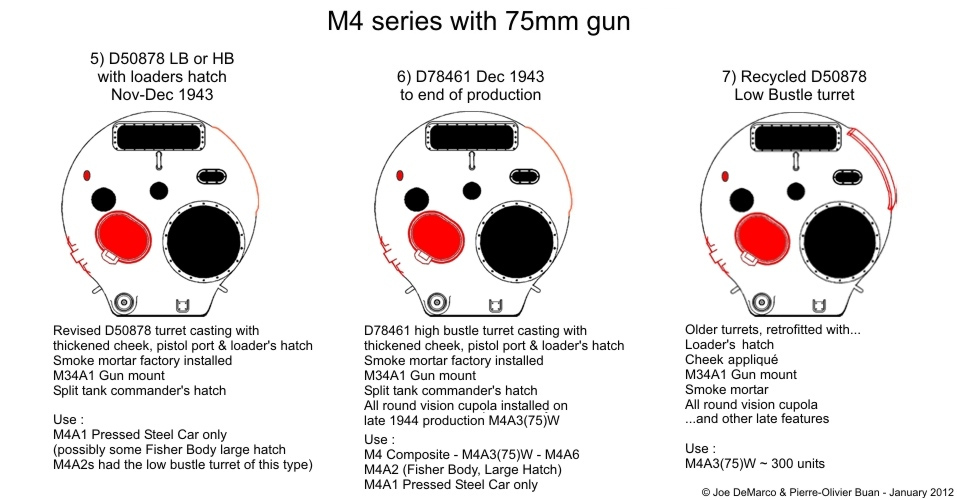
___________________________________________________________
First D50878 Turret as Seen on the T6 Pilot
The initial
design of the Sherman 75mm turret can be seen on the T6 pilot above.
This turret featured a gunner's rotor sight device (1), pistol ports
with M3 Lee style protectoscopes (2) on both the left and right sides,
the M3 Lee machine gun cupola (3), and a very simple gun shield (4)
without any sort of protection for the gun's rotor (5). Note that
the turret and the gun shield were not equipped with lifting rings.

The challenge in the development of the US Medium Tank was to
design a superstructure that could carry a turret large enough to
accommodate three men and mount a 75mm gun. For this purpose, it was
thought that the turret ring would need to have an inside diameter of 69
inches. In retrospect, this was one thing the designers "got right"
from the start. It was determined that the turret of the new Medium Tank
would be cast armor, while the upper hull would be of either welded or
cast armor construction. Above shows a left rear view of the T6 turret.
On subsequent turrets, the M3 type protectoscope (1) was replaced with a
solid door, and the pistol port on the right side was eliminated from
the design altogether. Originally, the T6 turret did not have lifting
rings (2). These were added to the turret and gun shield during
development and became standard. The 30 October 1941 date of the photo
gives an idea of the chronology. Another item that was retrofitted to
the T6 turret is the secondary antenna bracket (3) which also became a
standard feature. The turret basket was encased in steel mesh (4). It
wasn't until early 1943 that the Ordnance Department acknowledged that
this was a safety issue, since the mesh "trapped" the turret crew, and
isolated the drivers. In April, work was begun to redesign
("skeletonize") the turret basket. In August 1943, as part of a more
comprehensive "Quick Fix" Modification, the mesh was instructed to be
removed from existing Shermans.
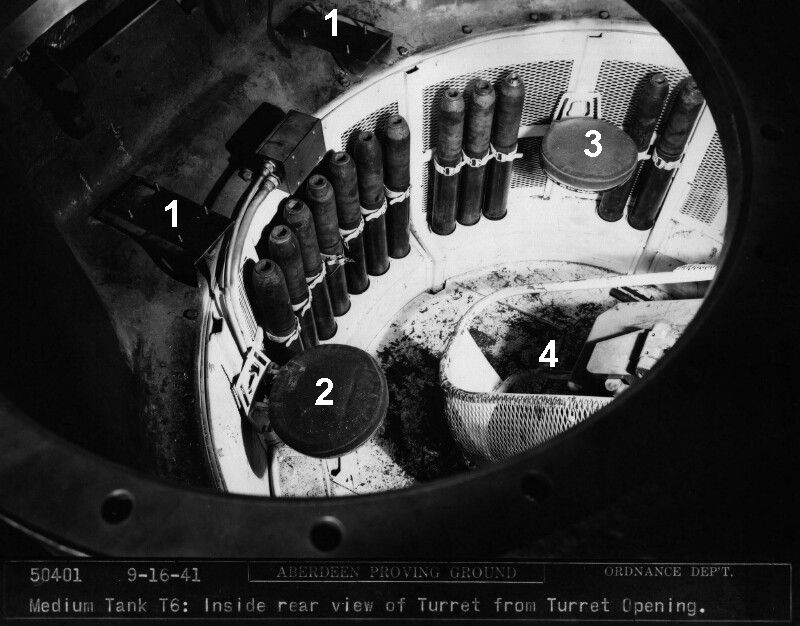
In this view
through the commander's hatch opening, note the brackets (1) installed
in the turret bustle. They could accommodate either the US or British
standard tank radio. The commander's (2) and loader's seat (3) were
affixed to the turret basket wall and were height adjustable. A bit of
the 75mm gun's breach and breach guard (4) can be seen. With only one
hatch in the turret, the breach guard presented an obstacle to the
loader as he attempted to escape in emergency situations. During the
initial design work, a loader's hatch was considered, but rejected in
the interest of simplicity. As a result of numerous combat reports, a
loader's hatch was added as a standard item on Sherman turrets in late
1943. Twelve ready rounds can be seen mounted to the wall of the turret
basket. Ready rounds were very popular with tank crews but were
extremely vulnerable. Along with the steel mesh around the turret
basket, the "Quick Fix" Modification ordered the elimination of the
ready rounds. Not only were they vulnerable, but as is evident here,
when in place, they also blocked the crew's escape.
"Low Bustle" D50878 75mm Turrets

The Sherman design was still being
revised as the first tanks rolled off the assembly lines. Some early
M4A1(75)s can be seen to have rotor sights as on the T6 pilot turret.
The exact number is unknown, but a Lima memo dated 21 January 1942
provides a clue when it states, "First 30 tanks using Rotor Device." It
is thought that 10 or so of the early Pressed Steel Car M4A1s also had
rotor sight turrets. The rotor sight was vulnerable to being fouled by
bullet splash and by April 1942, a revised D50878 casting that
incorporated a gunner's periscope replaced it in production. As best we
can tell, no other company's Shermans used the rotor sight device, so
this should only be seen on very early Lima and PSC M4A1s. The rotor
sight device was considered "not-battle worthy", and such turrets were
not to be shipped overseas to combat units. However, at least one
slipped through the cracks - a period photograph (right side) shows a "rotor
sight" M4A1 on a Sherman of the 751st Tank Battalion near Montemarano,
Italy on September 29, 1943.The left side photos above provide front and rear
views of the rotor sight casting on the only surviving Sherman known to
have this feature. This is "Michael", the second M4A1 produced by Lima
Locomotive Works. It would have been accepted in March 1942 and is the
earliest surviving Sherman in the world. It is on display at the Tank
Museum at Bovington in the UK.
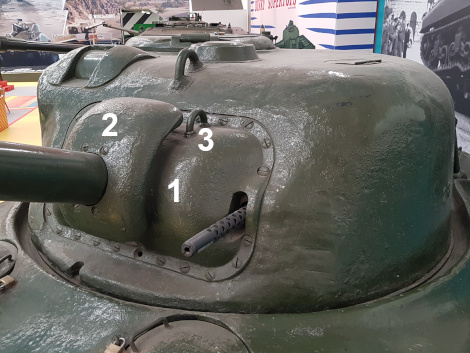
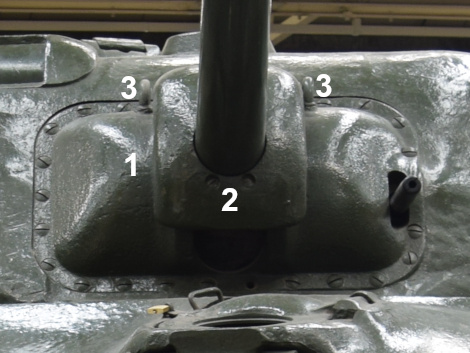
The
rather simple gun shield used on the T6 pilot was replaced with a
heavier casting (1), Part Number D50880 as seen here on "Michael" at
Bovington. A rotor shield (2) was added to protect the gun works from
bullet splash. This combination of gun, gun shield and "narrow" rotor
shield was labeled "M34 Gun Mount." The
gun shield was equipped with lifting rings (3) and on some early
production Shermans, they were welded on very close to the rotor shield
as seen here. Some of these "close mounted" lifting rings got damaged
and bent inward in service, which caused them to foul against the rotor
shield, and disable the elevation of the gun. Consequently, in the
Summer of 1942, the lifting rings were ordered to be mounted further
away from the rotor shield.
 The original design of the T6 pilot included the odd machine gun cupola
as used on the M3 Lee. However, in a conference on "presentation day," 3
September 1941, it was determined to replace it with a commander's
split hatch cupola similar to the one the British had designed for the
turrets of their M3 Grants. The photo above shows the hatch on
"Michael." It can be seen that both the hatch ring (1) and the hatch
halves (2) were castings, and we would point out to plastic model
companies that the hatch halves included "ridges" (3) on their outer
edges. On this example, the anti-aircraft machine gun pintle (4) that
was part of the hatch ring casting is small and includes some sort of
tightening fixture bolted on (inset). We suspect that the use of this
"small pintle" casting was limited like the rotor sight, to some of the
first few M4A1s produced by Lima and Pressed Steel Car. If one assumes
that the factory orientation of the pintle was facing front, then it can
be said that the revolving periscope (5) was mounted in the right-side
hatch "flap" as the British called it. For some reason, the British did
not include a lifting handle on their Grant cupolas, and the omission of
this simple component appears to have carried over to the Sherman
series for the first several months of production. Just looking at the
photo above, one wonders how users were supposed to lift the hatches.
The original design of the T6 pilot included the odd machine gun cupola
as used on the M3 Lee. However, in a conference on "presentation day," 3
September 1941, it was determined to replace it with a commander's
split hatch cupola similar to the one the British had designed for the
turrets of their M3 Grants. The photo above shows the hatch on
"Michael." It can be seen that both the hatch ring (1) and the hatch
halves (2) were castings, and we would point out to plastic model
companies that the hatch halves included "ridges" (3) on their outer
edges. On this example, the anti-aircraft machine gun pintle (4) that
was part of the hatch ring casting is small and includes some sort of
tightening fixture bolted on (inset). We suspect that the use of this
"small pintle" casting was limited like the rotor sight, to some of the
first few M4A1s produced by Lima and Pressed Steel Car. If one assumes
that the factory orientation of the pintle was facing front, then it can
be said that the revolving periscope (5) was mounted in the right-side
hatch "flap" as the British called it. For some reason, the British did
not include a lifting handle on their Grant cupolas, and the omission of
this simple component appears to have carried over to the Sherman
series for the first several months of production. Just looking at the
photo above, one wonders how users were supposed to lift the hatches.
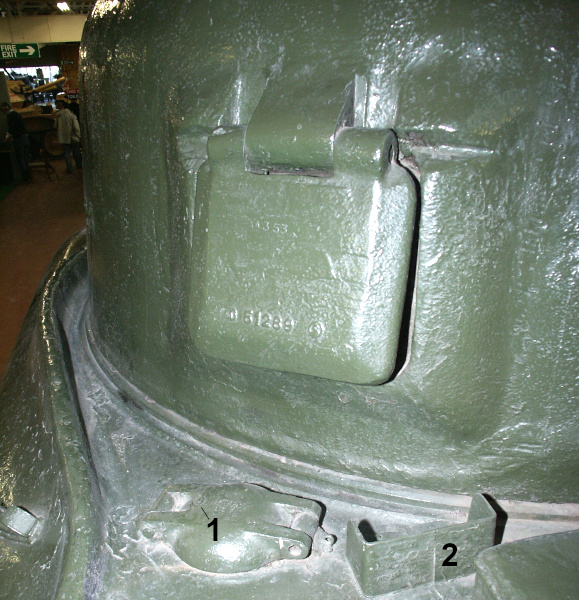 As mentioned, the T6's turret had pistol ports with M3 Lee style
protectoscopes on both the left and right sides. Production D50878
turrets had a pistol port on the left side only, and the solid door
casting was somewhat larger than the protectoscope. On "Michael," the
door's part number can be seen as D 51289 with the "S in a circle" logo
indicating the piece was cast by Symington-Gould of Rochester, New York.
The same logo is seen on the armored gas cap covers (1). Indeed, the "S
in a circle" logo appears on many of the cast components of "Michael"
including the drivers' hatches and direct vision blocks. The fire
extinguisher pull housing (2) is mounted in a non-standard position
facing up. The standard position was facing to the rear.
As mentioned, the T6's turret had pistol ports with M3 Lee style
protectoscopes on both the left and right sides. Production D50878
turrets had a pistol port on the left side only, and the solid door
casting was somewhat larger than the protectoscope. On "Michael," the
door's part number can be seen as D 51289 with the "S in a circle" logo
indicating the piece was cast by Symington-Gould of Rochester, New York.
The same logo is seen on the armored gas cap covers (1). Indeed, the "S
in a circle" logo appears on many of the cast components of "Michael"
including the drivers' hatches and direct vision blocks. The fire
extinguisher pull housing (2) is mounted in a non-standard position
facing up. The standard position was facing to the rear.
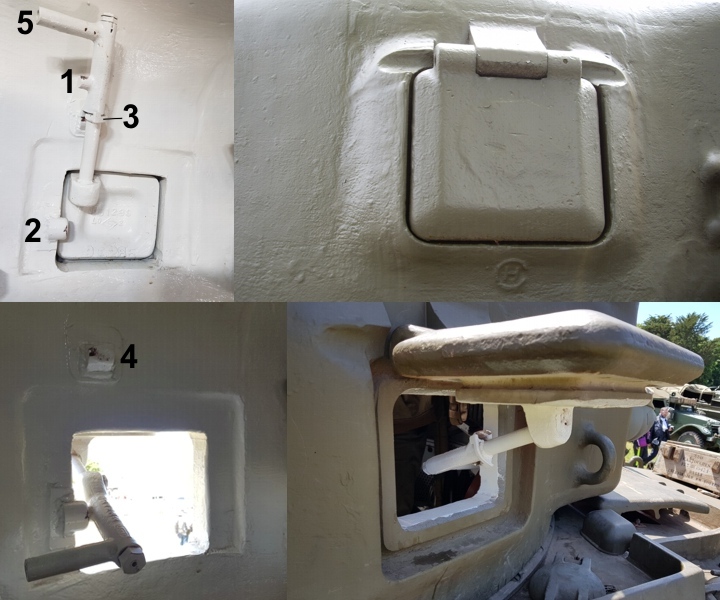 The montage above shows the pistol port in the open and closed positions
from both inside and outside the turret. One of the authors recently
had the opportunity to operate a pistol port, and his first impression
was that it was much heavier than expected. The L shaped handle or
“lever,” served as a simple prop, which held the door open, and locked
it into position by means of a “lever locking pin” (1) which could be
slipped into a “notch” (2) with a rotation of the handle. To secure the
pistol port door in the closed position, the handle was rotated until a
fixed “latch” (3) contacted a fitting (4) welded on just above the
pistol port opening. The “lever handle” (5) was installed with a rubber
bicycle type grip which is missing from this example.
The montage above shows the pistol port in the open and closed positions
from both inside and outside the turret. One of the authors recently
had the opportunity to operate a pistol port, and his first impression
was that it was much heavier than expected. The L shaped handle or
“lever,” served as a simple prop, which held the door open, and locked
it into position by means of a “lever locking pin” (1) which could be
slipped into a “notch” (2) with a rotation of the handle. To secure the
pistol port door in the closed position, the handle was rotated until a
fixed “latch” (3) contacted a fitting (4) welded on just above the
pistol port opening. The “lever handle” (5) was installed with a rubber
bicycle type grip which is missing from this example.
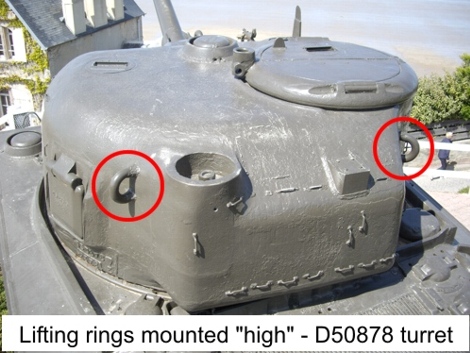

We might
generalize that early production D50878 turrets had the lifting rings
mounted "high" as seen on the left. We can narrow it down a bit further,
since the "highs" appear mostly on Shermans built by Lima Locomotive,
Pressed Steel Car and Fisher Body. Counting heads suggests that Lima and
PSC transitioned to the "low" position before the end of the Summer of
1942. ALCO, Baldwin, and Federal Machine appear to have started
production with the "lows", while Chrysler, Ford and Pullman produced
one or two of their first tanks with the "highs" before changing over to
the "lows." For some reason, Fisher Body manufactured M4A2s with high
turret lifting rings up until at least February 1943.
 Based
on feedback from the
using arms, a number of changes were introduced into production in
early 1943.
A direct sight telescope was added, & to protect it &
the coaxial MG,
the rotor shield was widened. The new configuration was
labeled
"M34A1 Gun Mount".
Based
on feedback from the
using arms, a number of changes were introduced into production in
early 1943.
A direct sight telescope was added, & to protect it &
the coaxial MG,
the rotor shield was widened. The new configuration was
labeled
"M34A1 Gun Mount".
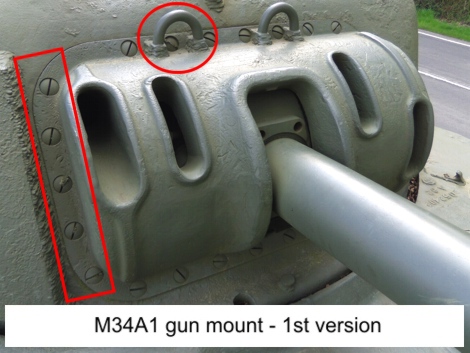

The first version of the M34A1 gunshield had
lifting rings & attachment flanges on the
top, bottom & right
side (left-side photo).
The final version of the gunshield eliminated the lifting rings,
&
moved the right side attachment points to the inside of the
turret,
thus dispensing with the outer flange on that side.
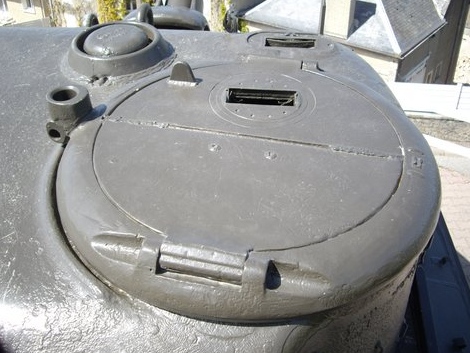
 There were a number of reports of crew injuries because the locks of the
original design of all of the Sherman's hatches were insufficient. When
in the open position, the heavy hatches were liable to slam down when
they brushed against tree branches or when the tank bounced around
violently as tanks do. As a result, positive hatch lock mechanisms were
introduced into production (circled in red) beginning around the Spring
of 1943, and modification kits for all of the hatches were provided for
depot and field retrofit.
There were a number of reports of crew injuries because the locks of the
original design of all of the Sherman's hatches were insufficient. When
in the open position, the heavy hatches were liable to slam down when
they brushed against tree branches or when the tank bounced around
violently as tanks do. As a result, positive hatch lock mechanisms were
introduced into production (circled in red) beginning around the Spring
of 1943, and modification kits for all of the hatches were provided for
depot and field retrofit.
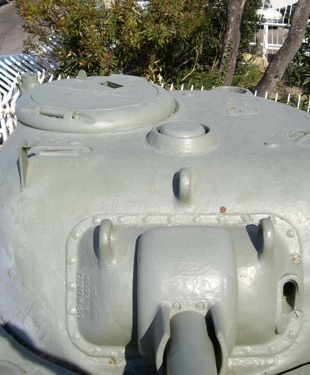
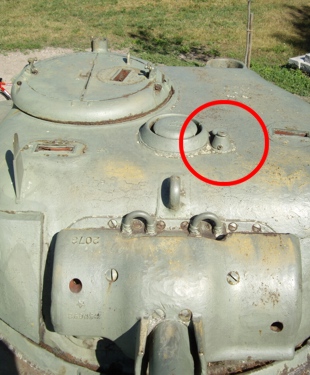
 A spot light (circled in red
on the center picture) was also introduced in early
1943. Many of the
earlier turrets that lacked the spot light & its
fittings (left-side
photo), had them retrofitted during later upgrades. The
right-side photo
shows how the spotlight was mounted on the fitting.
A spot light (circled in red
on the center picture) was also introduced in early
1943. Many of the
earlier turrets that lacked the spot light & its
fittings (left-side
photo), had them retrofitted during later upgrades. The
right-side photo
shows how the spotlight was mounted on the fitting.


Two sections of the right front interior of the turret were thinned or
scooped out to prevent "the knuckles of the operator from being skinned
or barked when using the hand traversing mechanism." As the Sherman
entered combat, reports came in that the enemy aimed for these "thin
spots." To protect this area, a patch on the right front of the turret
was introduced around Spring 1943, and modification kits were provided
for depot and field installation. The photo on the left shows the thin
spots on the interior turret wall, while the photo on the right shows
the modification installed on the exterior. The "turret patch" consisted
of two castings welded together in the middle as seen here. Each
casting is listed as having been 1 1/2 inches thick.

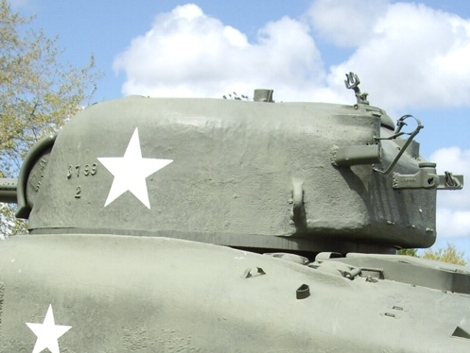
Heretofore, all 75mm turrets were cast with a pistol port on the left
side towards the rear (left-side photo). However, in April 1943 the
Ordnance Department determined that the pistol port was a ballistic
hazard and called for its elimination. Consequently, the D50878 turret
was redesigned without the pistol port as shown on the right.
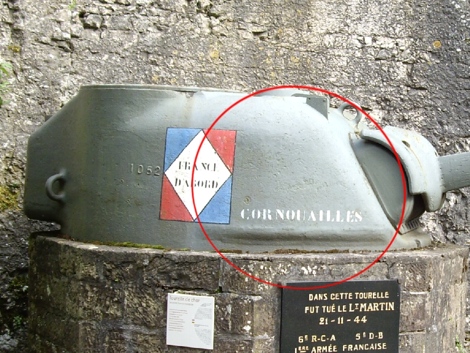
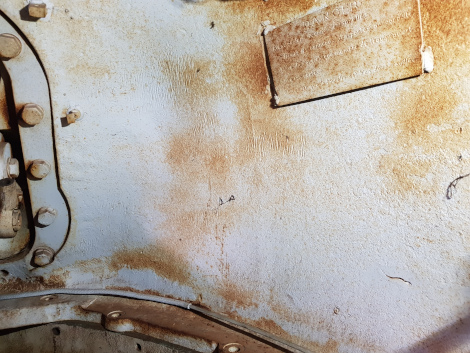
As part of the same redesign, the "thin spot" was remedied with what
modelers call the "cast in, thickened cheek" on the right front (circled
in red in the left side photo), thereby eliminating the need to weld on
the turret patch. The extent of the "bump out" of the "cast in,
thickened cheek" can be seen right where "Cornouailles" is painted.
Pierre-Olivier photographed the interiors of a few no pistol port, "cast
in, thickened cheek" D50878 turrets and as can be seen in the photo on
the right, the armor surface is flat with no scooped-out areas. There
does appear to be a little outward bulge. This leads us to think that
the armor in this area of the turret shell was actually moved out a bit
to give the operator room to work the traversing mechanism without
scraping his knuckles on the turret wall. On the exterior, we suspect
that the protruding part of the turret casting was not really
"thickened" but was intended to maintain the as designed armor basis of 3
inches on the front and 2 inches on the sides. We have no way of
measuring this, but if we are right, the useful descriptive term "cast
in, thickened cheek" would be something of a misnomer.
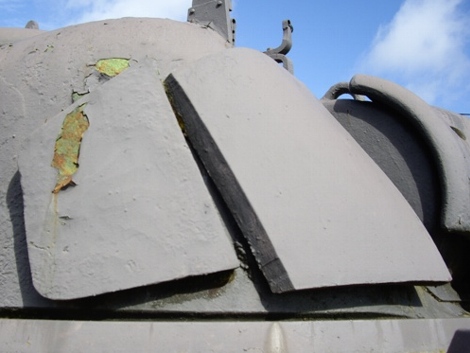
One of the interesting historical anomalies of French Lend Lease
Shermans, is that some are noted with the unnecessary application of the
"thin spot" patch on no pistol port, "cast in, thickened cheek" D50878
turrets. "Valois", "Massaoua" and "Chemin des Dames" are surviving
examples. The patch consisted of two cast sections, and the pieces were
not made to fit the contours of the revised turret. Consequently, the
patch was ill fitting with a noticeable gap between the two sections.
The surviving French 2nd Armored Division veteran M4A2, "Massaoua" above
shows a particularly poor fit. Lack of direction from US Ordnance
personnel, and/or simply a language barrier misunderstanding were the
likely culprits in the case of the unneeded turret appliqué.
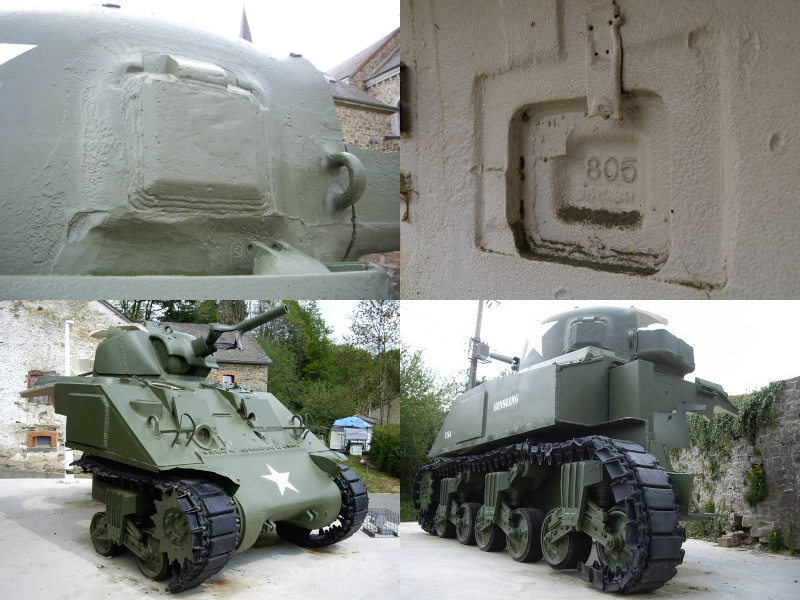 The "no pistol port" turrets
began to enter the production lines in the summer of 1943, but in the
meantime, factories and depots were directed to weld up any remaining
pistol port turrets that were in the pipeline. The "window" where
turrets were welded up appears to have run from about May to September
1943, even though the pistol port was "reinstated" on 23 July 1943. Of
course, not every pistol port was welded up. During this period,
inspectors at factories and depots reported incidences of Shermans
passing through with working pistol ports. Counting heads suggests
that, in most cases, the pistol port itself was used as the "blank off"
with the hinge barrels on the casting burned off or otherwise
removed. This may have been to ensure a watertight seal. The pistol
port was then welded on, both outside and inside. The photos above show
a typical job on the unusual "half a tank" monument in Wibrin, Belgium.
This M4 appears to be a US Army WW II battle casualty. The Serial
Number is not known, but the appearance suggests it would have been
accepted at ALCO in July or August 1943. For what it is worth, the
turret was cast by General Steel-Eddystone and is serial number 3663.
From "counting heads," we believe this turret would have been cast in
late April or early May 1943. Based on the similarity of the
welded-up pistol port to a few other GS-E turrets, we wouldn't be
surprised if the weld up job was done at Eddystone before the turret
was shipped out.
The "no pistol port" turrets
began to enter the production lines in the summer of 1943, but in the
meantime, factories and depots were directed to weld up any remaining
pistol port turrets that were in the pipeline. The "window" where
turrets were welded up appears to have run from about May to September
1943, even though the pistol port was "reinstated" on 23 July 1943. Of
course, not every pistol port was welded up. During this period,
inspectors at factories and depots reported incidences of Shermans
passing through with working pistol ports. Counting heads suggests
that, in most cases, the pistol port itself was used as the "blank off"
with the hinge barrels on the casting burned off or otherwise
removed. This may have been to ensure a watertight seal. The pistol
port was then welded on, both outside and inside. The photos above show
a typical job on the unusual "half a tank" monument in Wibrin, Belgium.
This M4 appears to be a US Army WW II battle casualty. The Serial
Number is not known, but the appearance suggests it would have been
accepted at ALCO in July or August 1943. For what it is worth, the
turret was cast by General Steel-Eddystone and is serial number 3663.
From "counting heads," we believe this turret would have been cast in
late April or early May 1943. Based on the similarity of the
welded-up pistol port to a few other GS-E turrets, we wouldn't be
surprised if the weld up job was done at Eddystone before the turret
was shipped out.

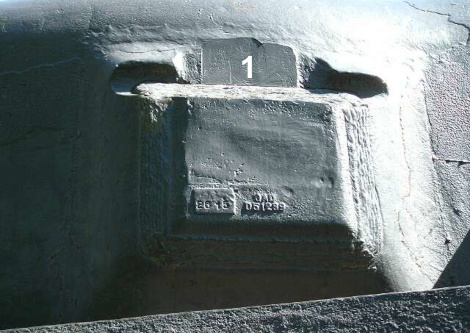
Pistol ports were
welded up in a number of different ways. Here we present two somewhat
common examples. The left side photo shows the welding
technique typically noted on Chrysler M4A4s. On the right we have
a method where the center hinge holder (1) was ground down and
the pistol port casting was welded on in such a way that it stood
out a bit. This particular job is on a General Steel-Commonwealth
turret with a casting date of "4-43" [April 1943]. Despite the
unpopularity of the elimination of the pistol port, it is evident
that the majority of US Army M4 and M4A1 75mm Shermans that fought
in the Normandy Campaign and beyond had either welded up or no pistol
port turrets.
 This Signal Corps photo is dated "24 July [1944]...near La Commune, France." It demonstrates how, without
the pistol port, it often took three men to load ammunition. A man on
the ground passed rounds up to a man standing highly exposed on the
tank, who passed the rounds through to a man in the commander's hatch.
Only one man on the ground, and somewhat protected by the tank, was
needed to pass ammunition through to a man at the pistol port. This M4A1
can be seen as USA 3036927 indicating that it was produced by Pressed
Steel Car in May 1943. This appears to be a case where the actual pistol
port casting was not used to blank off the opening. A beveled piece of
armor seems to have been employed instead. The inset shows a similar
application on a surviving turret cast by Union Steel, PSC's main
supplier of turrets. Some motion picture footage taken in Normandy shows
that USA 3036927 was a dozer tank named "Marauder" probably of the 2nd
Armored Division.
This Signal Corps photo is dated "24 July [1944]...near La Commune, France." It demonstrates how, without
the pistol port, it often took three men to load ammunition. A man on
the ground passed rounds up to a man standing highly exposed on the
tank, who passed the rounds through to a man in the commander's hatch.
Only one man on the ground, and somewhat protected by the tank, was
needed to pass ammunition through to a man at the pistol port. This M4A1
can be seen as USA 3036927 indicating that it was produced by Pressed
Steel Car in May 1943. This appears to be a case where the actual pistol
port casting was not used to blank off the opening. A beveled piece of
armor seems to have been employed instead. The inset shows a similar
application on a surviving turret cast by Union Steel, PSC's main
supplier of turrets. Some motion picture footage taken in Normandy shows
that USA 3036927 was a dozer tank named "Marauder" probably of the 2nd
Armored Division.
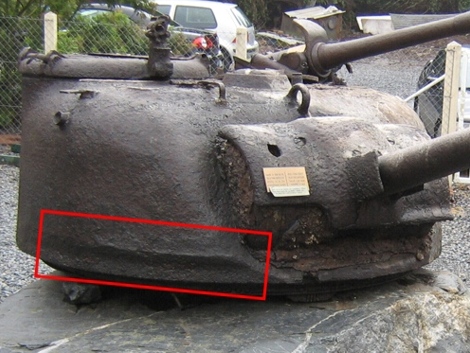
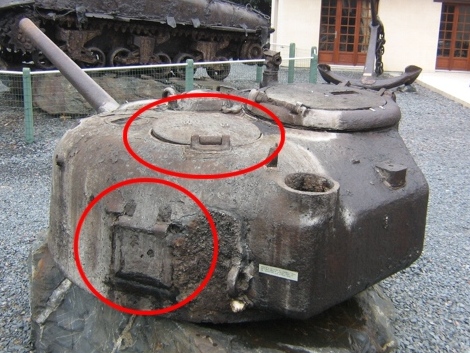
The
feedback from the using arms concerning the elimination of the
pistol port was so negative, that in July 1943, Ordnance voted to
reinstate it.
Feedback also stressed the need for a loader's hatch, so once again,
the D50878
turret was redesigned to include the pistol port as well as introduce
the
"oval loader's hatch." These turrets continued to have the
"thickened cheek" on the right front (all the items circled in red on
the photos above). Pressed Steel Car seems to have been the first
manufacturer
to introduce the D50878 turret with loader's hatch in late October 1943.
The first
ones were low bustle turrets like the one shown above. As Fisher-built
M4A2s
pretty much disappeared to Lend Lease (hence some difficulties in photo
and
surviving vehicles study) , we can only observe that
the oval
loader's hatch appears to have
been introduced on M4A2(75)s very
late in 1943 or early 1944. There are a few pictures of Soviet big
hatch
M4A2(75)s with low bustle turrets with loaders' hatches, which are
presumed to
be D50878s.
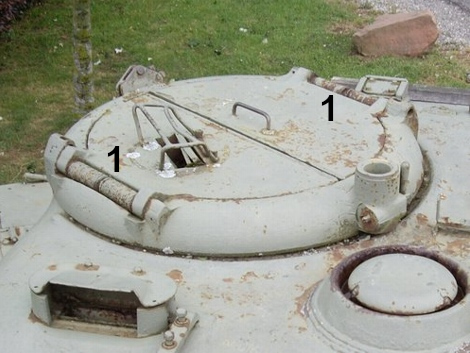

The commander's hatch was improved with the introduction of "turret
hatch D69993 with equilabrator." The hatch hinges were equipped with
integral springs (1) which made it easier for the crew to open and close
the heavy hatches. It is assumed that a more robust internal locking
mechanism was included with the new design, since the external hatch
locks (circled in the photo of the older model on the right) were no
longer installed. The redesigned hatch was released as a "critical
modification" with "No tanks without this item to be accepted after
11/8/43 [8 November 1943]." We can't confirm if the freeze date was
absolute, but we can observe that many Shermans produced in late 1943
are seen with the new hatches. Of course, the design carried over to the
D78461 high bustle turrets when they were introduced starting in late
November 1943.
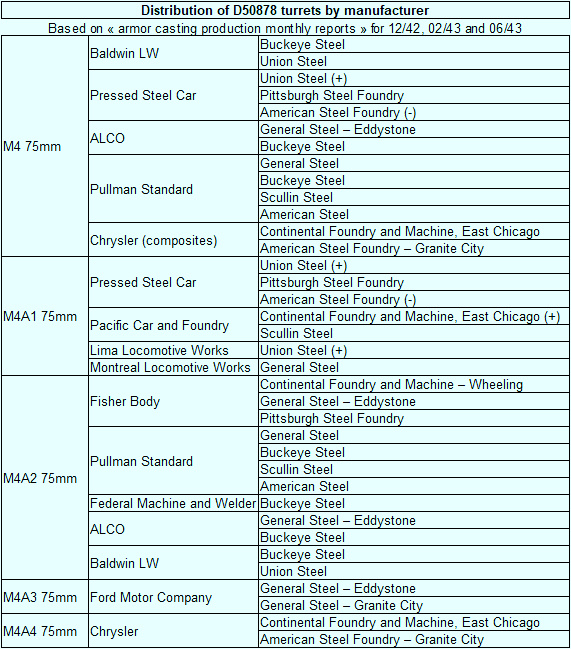
____________________________________________________________
"High
bustle" turrets - From the D50878 turret to the
D78461 turret
The 75mm turret rear profile
was raised a few inches to improve clearance for the larger drivers'
hatches of
the later hull designs. This clearance change resulted in the "high
bustle" turret, with older turrets termed as "low bustle". These
are modelers' terms only, the Army would have referred to the turrets
by
drawing number.
The
vast majority of high
bustle turrets were produced with a new Part Number - D78461. However
in November 1943, when Pressed Steel Car transitioned to the high bustle
turret,
the evidence suggest they continued to carry the old D50878
Part Number. Without more data, we can only speculate that PSC
might have used between 300 & 400 low bustle, loader's hatch D50878 turrets,
and between 200 and 300 high bustle, loader's hatch D50878
turrets.
Fisher Body used D78461
turrets on their M4A3(75)Ws right from the start in Feb, 1944. At
present, it
is not known if they used any high bustle D50878s as part of their
M4A2(75)
program.
From counting heads, it is
thought that Chrysler transitioned directly from the D50878 low bustle,
no
pistol port turret to the D78461 high bustle in late November, 1943.
"Low bustle"
75mm turret (part number D50878)
"High bustle"
75mm turret (part number D50878 or D78461)
Late "High bustle"
75mm turret (part number D78461)
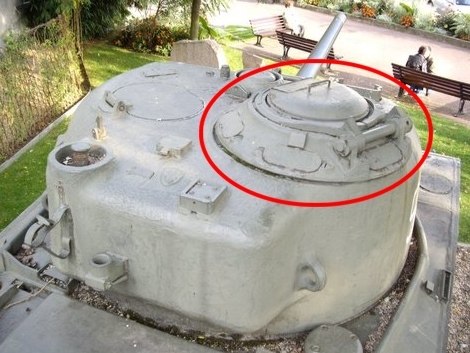
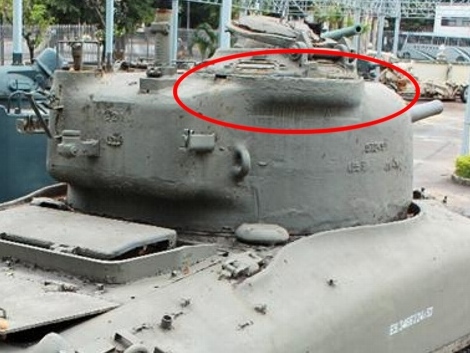 As supplies became available
in late 1944, 75mm turrets were factory equipped with the commander's
vision
cupola (left side photo). Modification kits were also supplied for
retrofit. Late
high bustle D78461 turrets have a bulge to better accomodate the
commander's
vision cupola (right side photo). This modification seems to have
appeared on
turrets cast from November 1944 onward.
As supplies became available
in late 1944, 75mm turrets were factory equipped with the commander's
vision
cupola (left side photo). Modification kits were also supplied for
retrofit. Late
high bustle D78461 turrets have a bulge to better accomodate the
commander's
vision cupola (right side photo). This modification seems to have
appeared on
turrets cast from November 1944 onward.
Recycled
"Low bustle" turrets

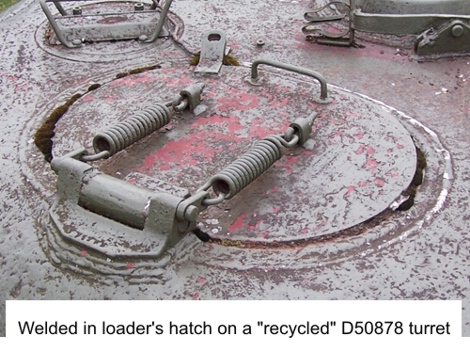
Due to the critical
foundry situation, Fisher Body agreed to accept 300 used D50878 turrets
left over from the retriever conversion program. They were to be
updated to
current standards, with M34A1 gun mounts & turret patches where
needed. A
loader's hatch was to be cut in. They were to be installed on large
hatch
M4A3(75)Ws at the rate of 100 per month starting in November 1944.
There are a
number of period photos of these, including some tanks with HVSS. Most
or all
of them appear to have been equipped with the commander's all round
vision
cupola. Perhaps a small number of them saw some combat in the ETO in
the
closing days. It's common knowledge that the low bustle turret caused
some
interference issues when mounted on a "big hatch" Sherman. However,
that didn't seem to have been a problem with all the low bustle, no
pistol port
turrets on many M4 Composites. In any case, the Fisher docs mention
that the
recycled turrets "would require flame cutting of some stock on the
lower
rear corners of the radio bulge to eliminate interference with the
drivers'
doors". These photos of a 1942 production Union Steel turret (S/N 871)
that was certainly recycled show hints of how some material was removed
from
the bottom corners of the turret bustle. The loader's hatch was also
neatly
welded in.
It is thought that some more low bustle bustle turrets received the
same
upgrade in the early 1950s. In that case, the 75mm gun was replaced
with a 76mm.
These "upgunned" Shermans were sent out as Military Assistance.
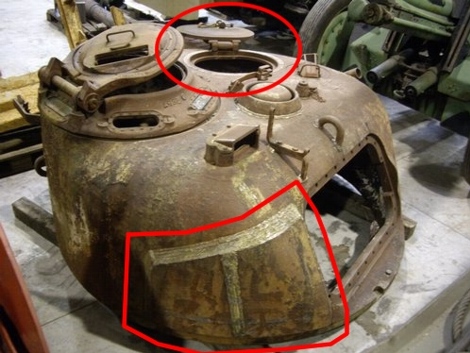
The way to distinguish between a recycled D50878 turret & a
late 1943
production D50878 with low bustle and loader's hatch is that the late
production will have a cast in thickened cheek, whereas the recycled
turret
will have the armor patch on the right front (as shown above). Also if
the
serial numbers can be read, the recycled turrets will have much lower
serial
numbers than the late productions ( the few late production turrets
identified
have S/Ns in the 4000 & 5000 range).
HOME
